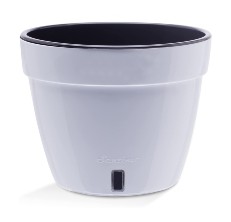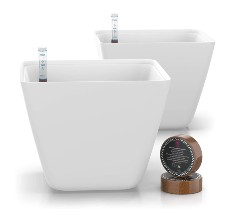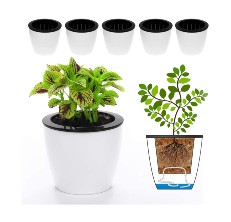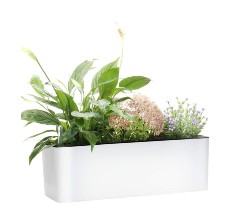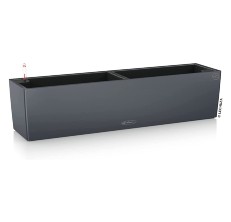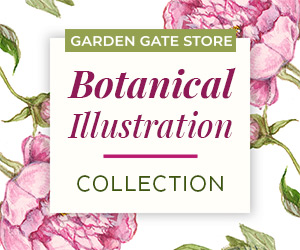Are you a plant lover who often forgets to water your house plants? Whether you’re working with tight schedules or find yourself traveling frequently, self-watering planters can make it easy to passively water your plants so they never go thirsty. Containers like these are equipped with a water reservoir that gives them access to water automatically. All you have to do is keep the planter filled with the right amount of water, and you’ll be good to go! For a planter that will water your greenery for you, check out the Santino Self-Watering Planter.
Are you a plant lover who often forgets to water your house plants? Whether you’re working with tight schedules or find yourself traveling frequently, self-watering planters can make it easy to passively water your plants so they never go thirsty. Containers like these are equipped with a water reservoir that gives them access to water automatically. All you have to do is keep the planter filled with the right amount of water, and you’ll be good to go! For a planter that will water your greenery for you, check out the Santino Self-Watering Planter.
Our Top Picks For Self-Watering Planters
Buying Guide: Self-Watering Planters
If you are shopping for self-watering planters but are spoilt for choice, we are here to help. Here are all the details you need to know before buying a top-of-the-line self-watering planter available on the market.
How Do Self-Watering Planters Work?
Self-watering planters have two primary methods that rely on capillary action to enable water movement in the reservoir to the pot. The first way uses a wick positioned inside the container with both ends placed in opposite directions. One end of the wick goes into the self-watering pot while the other remains in the reservoir. The wick, made of either a string or capillary mat, sucks water from the tank and facilitates its movement to the container. In the second method, the potting mix is designed to sit inside the source of water. Water moves from the bottom of the container to the rest of the sides through capillary. This design is standard, unlike the first.
Jaleesa from Green Mable further explains how these neat plant pots work in this video:
What Are the Benefits of Self-Watering Planters?
If you are wondering why you should buy a self-watering planter instead of a conventional planter, here are some benefits that will help you make an informed choice.
Efficient use of water
Since water is stored in an enclosed tank in a self-watering planter, the rate of evaporation is significantly low. Unlike using a watering can that sprays water on the plant’s surface and causes unnecessary waste, these planters ensure the plant utilizes water effectively by absorbing only what is needed through the roots. Therefore, if you are looking for a method that will help you save water while providing your plants with the needed water level, a self-watering planter will be suitable.
Consistent moisture levels
Your plants will enjoy consistent moisture levels without you having to tire watering them on a daily basis. Even when the weather is hot, plants will have a sufficient water supply and blossom without too much effort. These plant pots are ideal for plants that need constant watering to thrive. Conversely, succulents and plants like cactus do not do well in self-watering containers.
Prevention of plant diseases
Keep away fungal diseases from your plants by using these plant pots. Since water does not splash on the leaves, you will have healthy plants all year round.
What Factors to Consider When Shopping for a Self-Watering Planter?
There are factors you should look for when purchasing one of the best self-watering planters that will help your plants stay healthy while you are away. Some of them include:
Capacity
The number of plants a container can hold is necessary because it will help you determine the appropriate size for your plants. Some pots are small and can only have a few plants, while others are large enough to hold multiple plants effortlessly. Therefore, go for a highly-rated self-watering planter that will ensure the plants are well spaced. If you have a lot of plants, you can even consider a self-watering planter box.
Type of material
Manufacturers use different materials like premium quality BPA-free plastic and polypropylene to construct planters. The plastic material comes in various forms like lacquered and polished finishes that make it eye-catching. As for polypropylene, it is hard to break, which makes it a worthy investment.
Also, some models come with blends that are either used in place of soil or mixed with soil when planting. For instance, LECHUZA-PON is a substrate that acts as a natural storage for nutrients because it absorbs excess fertilizer and releases it back to the plant. This way, your plants get the right conditions to thrive by avoiding root damage from overfertilizing. On the other hand, coconut coir is obtained from coconut fiber and is characterized by proper aeration, excellent water holding capacity, and suitable pH, which are essential for healthy plant growth.
Refilling frequency
The refilling of self-watering planters varies depending on the size of the reservoir. While some self-watering pots require you to refill after two weeks, some can go up to four weeks without needing a refill. Most of the planters come with a water indicator that shows the level of water. This way, you will easily notice when the water level in your self-watering planter is low.
Size of pot
Different models come in varying sizes to suit all plant sizes. Remember, you should buy a pot that is just the right size to allow root growth to enable the healthy growth of your plants. Choosing a self-watering planter that is too big or too small causes growth stunting due to unfavorable conditions. Also, consider the appropriate depth to allow the plant to balance during all seasons.
Oxygen circulation
Oxygen is an essential component that plant roots need to have for healthy growth. When roots get soaked with water on a regular basis, they drown, suffocate, and ultimately rot. You should choose a pot that prevents drowning of the roots by providing a divider between the roots and the water reservoir. So, the roots get the right amount of water as well as oxygen for healthy growth.
How Do I Set Up a Self Watering Planter?
Here is a step-by-step guide on how to set up the self-watering pot:
Step 1: Follow the instruction manual to separate the inner container from the outer one.
Step 2: Place the moist mix at the bottom of the planting pot to facilitate the movement of moisture. If the pot you are using has a wick, ensure that one end is placed on the mix and the other on the reservoir.
Step 3: This is where the plants go in the potting mix. Plant your lovely plants in the self-watering planter and ensure they are well supported by the mix.
Step 4: Water plants using a can to sprinkle water on the surface of the container. This helps to remove all the air pockets present and settle the roots in the potting mixture. You will only need to use this watering method once. After that, the reservoir will come in handy.
Step 5: Let the water go down to the reservoir. Fill the reservoir appropriately.
Step 6: Monitor the water levels and refill as needed. However, it would be best if you did not let the tank dry out. If it does, moisten the mix before adding water to the reservoir to make it work effectively.
People Also Asked
Do self-watering planters need drainage holes?
Drainage holes are essential to facilitate the proper flow of water to prevent root rot. Water flows into the bottom lid in case of heavy rains or overwatering. If the pot does not have holes, you can drill two just above the reservoir.
Can self-watering planters be used indoors?
Yes, they are used for small indoor plants like perennials, tropical plants, and vegetables. But, these planters are not suitable for houseplants that thrive in moist soil because it is hard to regulate and maintain appropriate soil moisture.
How often do you fill self-watering pots?
The frequency of refilling will be determined by factors like levels of sunlight, season, and type of plant. However, every three weeks will be ideal. You can raise the humidity around the leaves by watering the top lightly.
Do self-watering plants attract mosquitoes?
Self-watering planters provide a conducive environment for mosquitoes to breed, which can be problematic if you have them indoors. You can prevent them from breeding by adding oil into the water. Alternatively, you can use a mosquito dunk.




